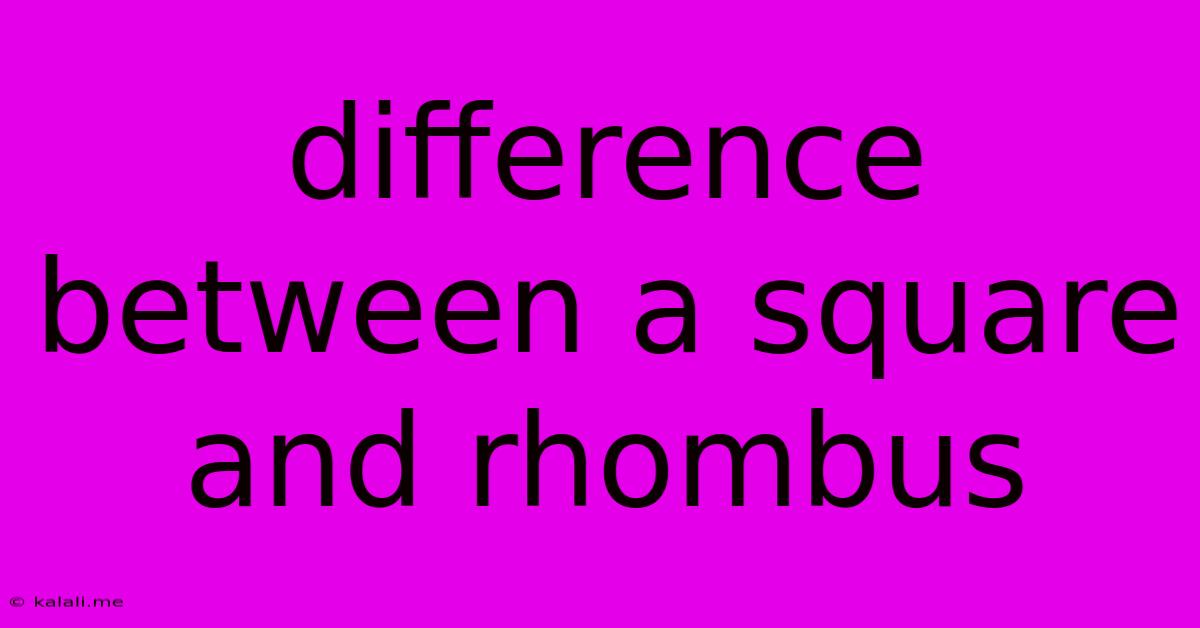Difference Between A Square And Rhombus
Kalali
Jun 15, 2025 · 3 min read

Table of Contents
Square vs. Rhombus: Unveiling the Key Differences
This article delves into the subtle yet crucial distinctions between squares and rhombuses, two quadrilateral shapes often confused. While both boast four sides of equal length, their differences lie in their angles and properties. Understanding these differences is crucial for geometry, mathematics, and even certain design applications. By the end, you'll be able to confidently identify and differentiate between squares and rhombuses.
What is a Rhombus?
A rhombus is a quadrilateral (a four-sided polygon) characterized by four equal-length sides. This is its defining feature. However, rhombuses don't necessarily possess right angles. Their angles can vary, resulting in different shapes. Think of it as a squashed or stretched square. Key properties of a rhombus include:
- Four equal sides: This is the fundamental property.
- Opposite sides are parallel: This makes it a parallelogram.
- Opposite angles are equal: The angles diagonally opposite each other are the same.
- Adjacent angles are supplementary: Meaning they add up to 180 degrees.
- Diagonals bisect each other at right angles: The lines connecting opposite corners cut each other in half and form 90-degree angles.
What is a Square?
A square is a special type of rhombus, and also a special type of rectangle. It inherits all the properties of a rhombus but adds a crucial element: right angles. This makes all the difference. A square is a highly symmetrical shape. Key properties of a square include:
- Four equal sides: Just like a rhombus.
- Four right angles (90 degrees): This is the key differentiator from a rhombus.
- Opposite sides are parallel: Inherited from its rhombus and rectangle properties.
- Diagonals bisect each other at right angles: Also inherited from its rhombus properties.
- Diagonals are equal in length: A unique property of squares.
The Key Differences Summarized:
The table below neatly summarizes the key differences:
| Feature | Rhombus | Square |
|---|---|---|
| Sides | Four equal sides | Four equal sides |
| Angles | Opposite angles equal, adjacent angles supplementary | Four right angles (90 degrees) |
| Diagonals | Bisect each other at right angles | Bisect each other at right angles, and are equal in length |
| Symmetry | Rotational symmetry of order 2 | Rotational symmetry of order 4, reflectional symmetry across diagonals and lines through midpoints of opposite sides |
Real-World Applications:
Understanding the difference between squares and rhombuses has practical applications in various fields:
- Engineering and Construction: Designing structures and foundations often requires precise geometrical understanding.
- Computer Graphics and Game Development: Creating digital art and game environments necessitates the accurate representation of shapes.
- Tile Design and Pattern Making: Many patterns and designs utilize squares and rhombuses for their aesthetic and mathematical properties.
Conclusion:
While both squares and rhombuses share the common trait of four equal sides, the presence of right angles distinguishes the square. A square is a specialized type of rhombus, possessing all its properties plus the added constraint of 90-degree angles, leading to greater symmetry and specific geometric characteristics. Remembering this fundamental difference ensures accurate identification and understanding of these important geometric shapes.
Latest Posts
Latest Posts
-
2500 In Words For A Check
Jun 15, 2025
-
A Positive Ion Is Known As A
Jun 15, 2025
-
A Sample Of Professors Is Selected And It Is Found
Jun 15, 2025
-
How Many Valence Electrons Does O2 Have
Jun 15, 2025
-
Ca Oh 2 Acidic Or Basic
Jun 15, 2025
Related Post
Thank you for visiting our website which covers about Difference Between A Square And Rhombus . We hope the information provided has been useful to you. Feel free to contact us if you have any questions or need further assistance. See you next time and don't miss to bookmark.